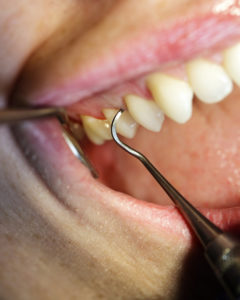 The Center for Disease Control stated recently that just short of 50% of American adults have some form of periodontal disease. Millions of Americans have gum disease and do not even know it. At Ponte Vedra Complete Dentistry, we attempt to educate everyone within reach about these issues with the hopes that we can help the community attain a higher level of oral health. We hope you enjoy and learn something in the process!
The Center for Disease Control stated recently that just short of 50% of American adults have some form of periodontal disease. Millions of Americans have gum disease and do not even know it. At Ponte Vedra Complete Dentistry, we attempt to educate everyone within reach about these issues with the hopes that we can help the community attain a higher level of oral health. We hope you enjoy and learn something in the process!
Gingivitis and Periodontitis
Gingivitis and periodontitis are the two most prevalent forms of gum disease. Gingivitis is like any other infection in the body. While there are many different causes of gingivitis, it is often the result of a lack of proper oral hygiene. Our bodies will mount an immune response to the local environment in the mouth. The body recognizes that there is a lack of health and attempts to remedy the situation. What results is a low grade chronic infection.
Periodontitis is more serious than gingivitis. Often when oral health has been neglected long enough, gingivitis progresses to periodontitis. This differs from gingivitis in a few major ways. First, while gingivitis just affects the gum tissues, periodontitis goes further. The bone that holds the teeth as well as the ligamentous attachments for the teeth become slowly destroyed. This eventually leads to tooth loss. Second, while gingivitis can be reversed and the gums can eventually return to health, periodontitis can only be stopped and not reversed.
What are the Signs and Symptoms of Gum Disease
There are many signs and symptoms of these diseases. Some examples are;
- Redness and swelling of gum tissues
- Gums that bleed easily during brushing or eating
- Chronic bad breath
- Loose teeth
- Painful gums
- Gums that have receded leading to more visible tooth structure than normal
How is this Diagnosed and Treated?
While the signs and symptoms listed above can indicate the presence of gum disease, other intra-oral diseases can create similar signs and symptoms. The only true way to determine the presence of this disease is a dental visit. Once diagnosed, the proper course of treatment can begin. First, a thorough cleaning is needed by a dental hygienist. This will create a more healthy environment in the mouth. More advanced forms of this disease can require more aggressive treatments.
After initial therapy, new oral hygiene practices may need to be adopted. The dentist and hygienist can provide adequate training in this area. Routine dental visits are especially important for patients that have had or currently have gum disease.
We welcome questions and new patients. You can contact us electronically at any time or call us at (904)285-7711.



